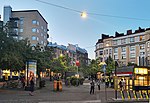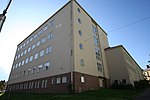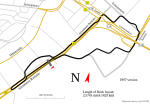Sörnäinen metro station
1984 establishments in FinlandEuropean rapid transit stubsHelsinki Metro stationsRailway stations opened in 1984Sörnäinen

Sörnäinen metro station (Finnish: Sörnäisten metroasema, Swedish: Sörnäs metrostation) is a station on the Helsinki Metro. It serves the central Helsinki districts of Sörnäinen and Kallio. Sörnäinen is the easternmost station on the system to be located underground. The station was opened on 1 September 1984 and was designed by Jouko Kontio and Seppo Kilpiä. It is located 900 meters from Hakaniemi metro station, and 1.1 kilometers from Kalasatama metro station. The station is situated at a depth of 25 meters below ground level and 3 meters below sea level.
Excerpt from the Wikipedia article Sörnäinen metro station (License: CC BY-SA 3.0, Authors, Images).Sörnäinen metro station
Helsinginkatu, Helsinki Alppiharju (Central major district)
Geographical coordinates (GPS) Address Nearby Places Show on map
Geographical coordinates (GPS)
| Latitude | Longitude |
|---|---|
| N 60.1875 ° | E 24.961111111111 ° |
Address
Helsinginkatu 2a
00500 Helsinki, Alppiharju (Central major district)
Finland
Open on Google Maps










